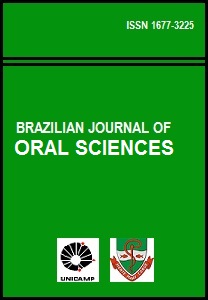Abstract
The aim of this study was to compare the dental caries prevalence, in the year 1998, in two cities of big population, one of them fluoridated, since 1975, the city of Bauru, and other, named Jaú, where the fluoridation was interrupted (1992). The two cities are located in the State of São Paulo, Brazil. The sample was composed by 189 children of 5 years old and 163 of 12 years old, both gender, distributed between Bauru and Jaú. The statistical analysis was made with use of the Student’s “t” test. The dental caries was registered with the use of the DMFT index and observed the percentage of children caries-free. No statistical differences were observed, considering the age and the cities. The outcomes showed that dmft of the 5 years old children in Bauru and Jaú were 1.06 1.32, respectively; and the DMFT of the 12 years old children were 2.92 and 3.45 respectively. The percentages of 5 years old caries free children in Bauru and Jaú were 54.84% and 55.21%, respectively. Considering the age of 12, the caries-free children were 21.34% in Bauru and 22.73% in Jaú. In the parameter evaluated the children living in Bauru, which has fluoridated water for more than 20 years, did not differ from the children from Jaú, which suffered interruption in the water fluoridation supply. Our results are differ from analysis performed during the decades of 70 and 80, when studies showed that the interruption in the fluoridation of drinking water was followed by an increase in the prevalence of dental decay. In conclusion, our data suggest that the interruption in water fluoridation at Jaú did not bring about a tendency towards caries increase. These results can be possibly explained by the use of fluoridated toothpaste, associated with the ingestion of other sources of fluoride and the presence of the “halo effect”. Our results indicate that the availability of other sources of fluoride must also be considered and taken into account in the planning of programs in public health dentistry.References
Atwood D, Blinkhorn AS. Dental Health of schoolchildren 5 years after water fluoridation ceased in Southwest Scotland. Int dent J. 1991; 41(1): 43-8.
Buendia OC. Fluoretação de águas: manual de orientação prática. São Paulo: American Med;1996.
Burt BA. The changing patterns of systemic fluoride intake. J Dent Res. 1992; 71(sp. Issue): 1228-37.
Dean HT. Endemic fluorosis and its relation to dental caries. Publ Hlth Rep. 1938; 53: 1443-52.
Dini EL, Holt RD, Bedi R. Comparison of two indices of caries patterns in year old Brazilian children from area with different fluoridation histories. Int Dent J. 1998; 48(4): 378-85.
Kunzel W, Fischer T. Caries prevalence after cessation of water fluoridation in La Salud, Cuba. Caries Res. 2000; 34(1): 20-5. Universidade de São Paulo, Faculdade de Saúde Pública.
Levantamento epidemiológico de saúde bucal: Estado de São Paulo, 1998. São Paulo: FSP/USP; 1999.
Murray JJ. Prevalence of dental caries : retrospect and prospect. Dent.Update.1998; 25: 374-8.
Narvai PC, Castellanos RA, Frazão P. Prevalência de cárie em dentes permanentes de escolares do município de São Paulo, SP, 1970-1996. Rev. Saúde públ. 2000 abr; 34(2): 196-200.
Pereira AC, Da Cunha FL, Meneghim M de C, Werner CW. Dental caries and fluorosis prevalence study in a nonfluoridated Brazilian community: Trend analysis and toothpaste association. ASDC J Dent Child. 2000; 67(2): 132-5.
Pinto VG. Saúde Bucal Coletiva. São Paulo: Ed Santos; 2000.
Sëppa L, Kärkkäinen S, Hausen H. Caries frequency in permanent teeth before and after discontinuation of water fluoridation in Kuopio, Finland. Community Dent oral Epidemiol. 1998; 26(4): 256-62.
Sëppa L, Kärkkäinen S, Hausen H. Caries trends 1992-1998 in two low-fluoride finish tows formerly with and without fluoridation. Caries Res. 2000; 34: 462-8.
Stephen KW, McCall DR, Tullis JI. Caries prevalence in Nothern Scotland before, during, and 5 years after, water defluoridation. Br Dent J. 1987; 163(10): 324-6.
Thomas FD, Kassab JY, Jones BM. Fluoridation in Anglesy 1993: a clinical study of dental caries in 5-years-old children who had experinced sub-optimal fluoridation. Br Dent J. 1995; 178: 55-9.
Warnakulariya KA, Balasuriya S, Perera PA, Peiris LC. Determinig optimal levels of fluoride in drinking water for hot, dry climates – a case study in Sri Lanka. Community Dent Oral Epidemiol. 1992; 20: 364-7.
Wiktorsson AM, Martinsson T, Zimmerman M. Caries prevalence among adults in communities with optimal and low fluoride concentrations. Community Dent Oral Epidemiol. 1992; 20: 359-63.
World Health Organization: Oral health surveys: basic methods. Geneva; 1997.
The Brazilian Journal of Oral Sciences uses the Creative Commons license (CC), thus preserving the integrity of the articles in an open access environment.

